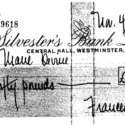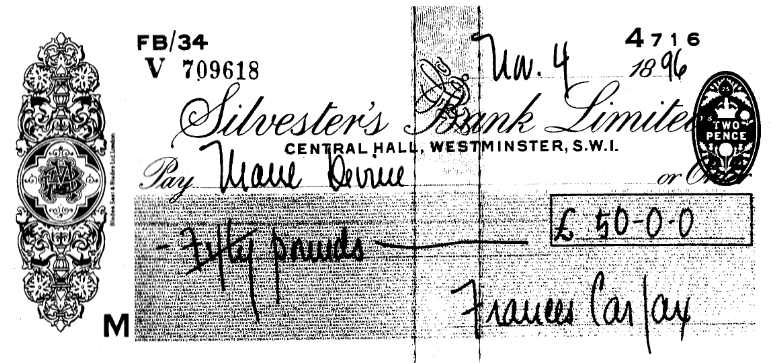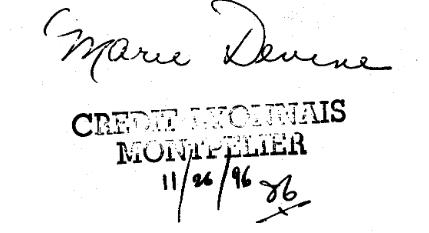A Scion Society of The Baker Street Irregulars

A Check on Lady Frances (1955)
“She banks at Silvester’s.”
– The Adventure of Lady Frances Carfax (LADY)
According to the distinguished French criminologist, Alphonse Bertillon, it is impossible for a bird to fly through a cloud without leaving traces. And so, while passing near Montpelier during one of my recent trips through Southern France, I decided to investigate a bird of another color. Not resisting the strange inclination which drew me as a magnet into the heart of the town, I went directly to the Rue de Trajan, and as if guided by hypnotic force, pulled up at the curb in front of number 11 . In reply to my ring, a small elderly balding man, slightly stooped over, in his shirtsleeves, opened the door.
“Monsieur Vibart?” I asked.
The man nodded, swung the door wider, and stepped aside as if to invite me inside.
“Monsieur Jules Vibart?”, I asked, incredulously.
The man regarded me sharply. “Non, monsieur. Jules Vibart was my brother. He was killed by those cuchons of Boches in the first great war. I am Jaques Vibart. After Jules died I came here to live with my sister-in-law. We have lived here these many years.” He stepped back and motioned me to come in. “Entrez, monsieur, si vous voulez.”
M. Vibart led the way down a darkened hallway to what I assumed was the family parlor, a shabby room, cluttered with books and papers, but comfortably furnished in a simple old fashioned way.
“What was it, monsieur, that you wished to know about my brother Jules?”
It was a trifle difficult to explain exactly the mission which had drawn me to this house in the Rue de Trajan. It could only end, I felt sure, in a mad goose-chase. And yet, here I was inside number 11 and, wonder of wonders, a man by the name of Vibart was, in the flesh, sitting across the table from me. Perhaps Bertillon was correct. It was (in the words of the King of Siam) a puzzlement.
“Let me get this straight, I remarked. “You are the brother of Jules Vibart. Tell me, monsieur, was he at one time in service?”
The man opposite me wrinkled his forehead.
“I mean, what occupation had your brother?”
“Ah, I comprehend,” said the old man. “Jules was for many years one of the head-waiters at the National Hotel at Lausanne.”
“Then it’s true!” I cried. “And you say this Jules Vibart married. With whom did he marry? Could it have really been Marie —–?”
“Marie Devine, her name, monsieur,” concluded the old man, quietly.
My head was pounding. I felt the blood in my veins tingling with excitement, for I knew I now was closing in on great discoveries.
“And is Madame Jules Vibart still alive?” I queried, almost in a whisper.
“But certainly,” said Jaques. “Madame Marie is gone to the public gardens where she takes for herself a little promenade each afternoon about this time. She will return around five hours less a quarter.” Jaques looked at me again quizzically. “But what is it that you desire of Marie, monsieur?”
“My desire is,” I replied directly, “to question Madame Marie about her former employer, Lady Frances Carfax. I have come to confirm some of the facts about Lady Frances originally set down by Dr. John H. Watson of Baker Street, London.”
“Ah, so . so . . ” mused the old man across the table. “Marie has often spoken of Lady Frances. A magnificent woman indeed. Monsieur, would you take a glass of wine while we are waiting?”
Jaques brought forth a bottle of excellent Vouvray and some bread and cheese, and we chatted away the time until suddenly we heard the front door close, and there was a light step in the hallway. It was precisely a quarter before five.
The former Marie Devine came into the room. Her age was indeterminable. She was still handsome and bore every sign of having in her youth been a very lovely woman. Jaques introduced us and we quickly got down to the subject at hand.
“Monsieur” she said with a faint smile. “Lady Frances was a magnificent person. I was devoted to her. I looked after her carefully and when we traveled I always kept her heavy trunk locked, but scrupulously. Lady Frances, as you remember, possessed some very remarkable old Spanish jewelry and curiously cut diamonds.¹ These she always carried with her in that trunk.”
“But why did you leave her, that last trip to Lausanne?” I asked.
“Ah, well.” Marie Vibart gave a little shrug. “When Lady Frances had a flare-up of temper I could forgive the dear Lady. But she questioned my honesty, and that I could not forgive her, monsieur.”
“That I can well understand, Madame.”
“Jules had already asked me to marry, and so, . . . “Madame Vibart spread her hands expressively,” I left Lady Frances and departed with Jules. We were married and settled down here in Montpellier where we lived happily these many years.”
No one spoke for a minute as we three thought back over those changing years.
“And you did not hold any bitterness against Lady Frances?” I asked, as Jaques filled my glass again.
“But no, a thousand times no!” exclaimed Madame Vibart. “Do you know what Lady Frances gave me for a wedding present when Jules and I were married? Here, let me show you something. Jules and I were so proud of this present we had a photograph taken of it to show all the world!”
The former Marie Devine went over to a bookcase and drew out a dog-eared leather album. Some of the pictures had come unpasted and were stuck in between the pages haphazardly, but she leafed through the book until she came to one page displaying a single item, firmly in place.
“Voila!” she cried in delight. “There now, what do you think of that for a wedding present!”
My eyes leaped to the page and my heartbeat quickened.
There in plain view was the replica of a check on Silvester’s for fifty pounds!
At long last, here was the end of my mission—almost. With Madame’s express permission, I borrowed the exhibit and had it copied at a nearby photographer’s shop, making sure that the original was returned safely to the little old woman in the Rue de Trajan.
You doubt it? Zut alors! Let me show it to you, exactly as it was shown to me by Marie Devine, formerly personal maid to Lady Frances Carfax.

And here, too, is a photostat of Marie’s endorsement.

(In order to have photographed the endorsement, it would appear that Marie must have corresponded with Lady Frances after the check had been cashed at the Credit Lyonnais. On this point, which is sufficiently confusing to be interesting, I must admit I did not question her.)
¹ Obviously Marie is well acquainted with Watson’s record of the case!
Originally printed in the July 1955 issue of The Baker Street Journal (Volume 5, Issue 3, pages 133-138)
Thayer Cumings, BSI, was an advertising executive with Batten, Barton, Durstine and Osborn of New York and held the investiture of Colonel Elias Openshaw with the Five Orange Pips of Westchester County. Cumings was investitured into the Baker Street Irregulars in 1953 as His Last Bow. In 1968, he self-published Seven on Sherlock on behalf of the Five Orange Pips.

Sorry, comments are closed for this post.